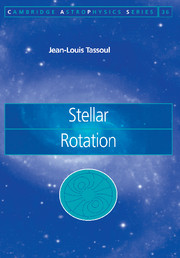4 - Meridional circulation
Published online by Cambridge University Press: 15 August 2009
Summary
Introduction
In Section 3.3.1 we noted that the conditions of mechanical and radiative equilibrium are, in general, incompatible in a rotating barotrope. This paradox can be solved in two different ways: Either one makes allowance for a slight departure from barotropy and chooses the angular velocity Ω = Ω(ϖ, z) so that strict radiative equilibrium prevails at every point or one makes allowance for large-scale motions in meridian planes passing through the rotation axis. The first alternative is mainly of academic interest because there is no reason to expect rotating stars to select zero-circulation configurations. Moreover, these baroclinic models are thermally unstable with respect to axisymmetric motions, as well as dynamically unstable with respect to nonaxisymmetric motions (see Sections 3.4 and 3.5). Hence, the slightest disturbance will generate three-dimensional motions and, as a result, a large-scale meridional circulation will commence. The second alternative was independently suggested by Vogt (1925) and Eddington (1925), who pointed out that the breakdown of strict radiative equilibrium in a barotrope tends to set up slight rises in temperature and pressure over some areas of any given level surface and slight falls over other areas. The ensuing pressure gradient between the poles and the equator thereby causes a flow of matter. In fact, it is the small departures from spherical symmetry in a rotating star that lead to unequal heating along the polar and equatorial radii, which in turn causes large-scale currents in meridian planes.
- Type
- Chapter
- Information
- Stellar Rotation , pp. 93 - 137Publisher: Cambridge University PressPrint publication year: 2000

